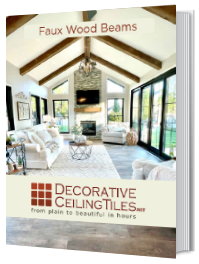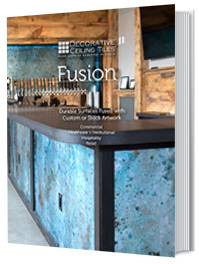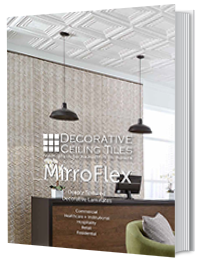How to Choose Faux Brick Panels - Ultimate Buying Guide
Written by Milan Jara on 17th Feb 2022

Faux brick panels are an excellent addition to walls in your kitchen, living room, fireplace, and basement if you want to add a brick-inspired decorative appeal.
This article shows you how to choose faux brick panels to ensure you pick the best fit for the specific space where you want to install a faux brick wall.
What Are Faux Brick Panels?
Faux brick panels are pre-assembled, compound blocks that mimic the color, texture, and shape of real brick.
Each brick wall panel is shaped like a tile but is considerably bigger like several tiles joined into one block. The result is a stylish brick pattern that looks like several individual bricks merged to form a large board, yet each brick maintains its singular features.
Faux brick panels lack structural integrity and are not used on their own to make up a full-fledged wall. Instead, you place them on an already existing wall for decorative purposes.
The lack of structural integrity in faux 3D wall panels stems from the fact that they aren't made of real brick. They are artificial materials without the solid three-dimensional figure of an actual brick, have less solid matter than real bricks, and are lightweight.
When you want to put up a brick-style wall, you have three options.
First, you can use real brick, which has the most solid matter and is heavy. Second, you can use brick veneer or veneer brick, which is real brick but with less solid matter since it is thinner.
Unlike real brick that makes a wall on its own, brick veneer is placed on an already existing wall to add a decorative touch. However, both real brick and veneer brick require masonry to hold the individual pieces together.
The third option is to use faux brick panels as wall decor to imitate the look of actual brick. Unlike real brick and veneer brick, faux brick wall panels do not require masonry. You can simply attach each decorative wall panel using adhesive and nails or screws.
What to Consider When Buying Faux Brick Panels
After making up your mind to add a layer of decorative wall panels on any wall in your home, you need to consider a few things before buying the panels.
This section discusses the key things you should consider when adding faux brick paneling to your home.
Nature of the Existing Wall
How you want the finished wall to look is a significant concern when choosing the best brick wall panels. You'll want to check various aspects of the wall, such as:
- Construction material
- Age
- Condition of the surface
- Structural integrity
The construction material determines whether or not you'll do any brick paneling in the first place. Faux panels are usually placed on stone walls or plastered surfaces. They are rarely put up on timber or wooden walls, especially when the surface is not even.
You'll want to fix the faux wall panel on an even wall surface where it stands better chances of lying flat with no air pockets between it and the construction material. This is more appropriate with a stone or plaster wall than uneven timber surfaces.
The age of the wall is also a determining factor when you want to put up a DIY faux brick wall. An old wall that has lost its luster is a ripe candidate for new wall paneling, while newer walls may not need it as they still have some kick.
The condition of the wall surface influences your decision to put up faux brick paneling, too. If the wall has new paint on it, you might want to wait a bit longer because applying construction adhesive may ruin the paint.
If the wall has old paint, you can add decorative panels to alter its look. However, ensure the paint doesn't flake. Otherwise, you risk ruining the panels because of the paint debris.
You might also have to consider the texture of the wall. An overly rough or uneven wall will give you trouble getting the construction adhesive to hold. Also, you might damage some of the brick panels if you have to press and bend them to fit into the space.
As noted earlier, faux brick panels lack structural integrity, and you can only place them on an already established wall. Although they are pretty lightweight, you must place them on a wall with good structural integrity to prevent damage. The good thing is that they add minimal thickness to the wall.
The wall should also be strong enough to withstand the boring screws or nails you use to hold the panels in place.

Color Matching
If you can't find faux brick wall paneling with color that matches the exact color of your furniture or other walls, it should at least complement the colors of such items.
An interior designer can help you determine which paint color best matches the faux brick panels to enhance the overall look and deliver the desired decorative effect.
To erect a matching or complementary faux brick wall, you can try out different lighting conditions with differently colored faux brick wall panel samples until you find the one that works best with your space. This is especially important when installing the panels indoors.
Some common colors include white for reflectivity and the traditional dark red bricks with white grout seams. Other colors are terracotta, rusty amber, burnished red, scorched cream, and coconut white.
Installation Location
The installation location is the place you're putting up the faux brick panels. Most of the time, you'll want to place them on an interior surface rather than an exterior one where they are exposed to harsh weather.
Some indoor places where you can add faux brick wall paneling to introduce a new accent wall style include the kitchen, fireplace, living room, and basement.
You can also use faux brick paneling to cover up an old exposed brick wall if the entire wall has outgrown its rustic appeal and requires some sight-lifting.
Adding faux paneling will hide the exposed brick and result in a feature wall that adds a touch of energy and renewed interest in the room.
However, when installing near a fireplace or in the basement, you must ensure the brick panels are not exposed to fire or damp conditions.
Wall panels made of pure polyurethane can easily catch fire, while the adhesive of those placed in damp basements will quickly weaken.
Additionally, you must ensure there are no accessible piping systems within the wall that the screws or nails could poke.
Installation Requirements
Faux wall panels are fairly easy to install. It takes just a few steps, but if you find yourself struggling with the task, you can always seek out an experienced professional to help with the installation process.
If you choose to install faux brick panels yourself, ensure you have the right skills for the job. It's also best to have someone with you to help with activities like cutting, labeling, attaching, and doing finishing touches.
Other aspects to consider when installing these panels include tools or materials, fire ratings, and the need for specialized molding or corner pieces.
Some tools and materials you'll need to attach faux brick wall panels include:
- Spackle - a putty for filling holes or cracks and other small deformities in plaster, drywall, or wood
- Soft paint brush - for dusting the installed panels and applying paint on the exposed nails, screws, or along each grout line
- Sanded caulk
- Caulking gun
- Tape measure
- Screw gun, screwdriver or nail gun
- Circular saw - for cutting the panels
- Putty knife
- Construction adhesive
- Grout with matching colors
Home Ownership Status
While you may have all the freedom you want to install faux brick wall paneling in your home, you may not have the liberty to do so in a house you rent or lease.
If you want to install the brick wall in a place that is not your own home or house, you must ask the owner first if they are comfortable with the modification. Failure to do so may result in you breaking the lease agreement, which could have undesirable consequences.
Furthermore, adding a faux brick wall panel might reduce your home resale value if you add it in a home without brick as an architectural feature. It can easily get dismissed as brick wallpaper meant only for decorations when used in such a situation.
Conclusion
This article discussed the key factors to consider when choosing faux brick panels. These include the nature of the intended placement wall, color-matching, location for the installation, installation requirements, and homeownership status vis-a-vis the resale value.
You can check out our collection of faux brick wall panels here. If you are struggling with what panels you should choose, you can always seek the help of a qualified interior designer.




